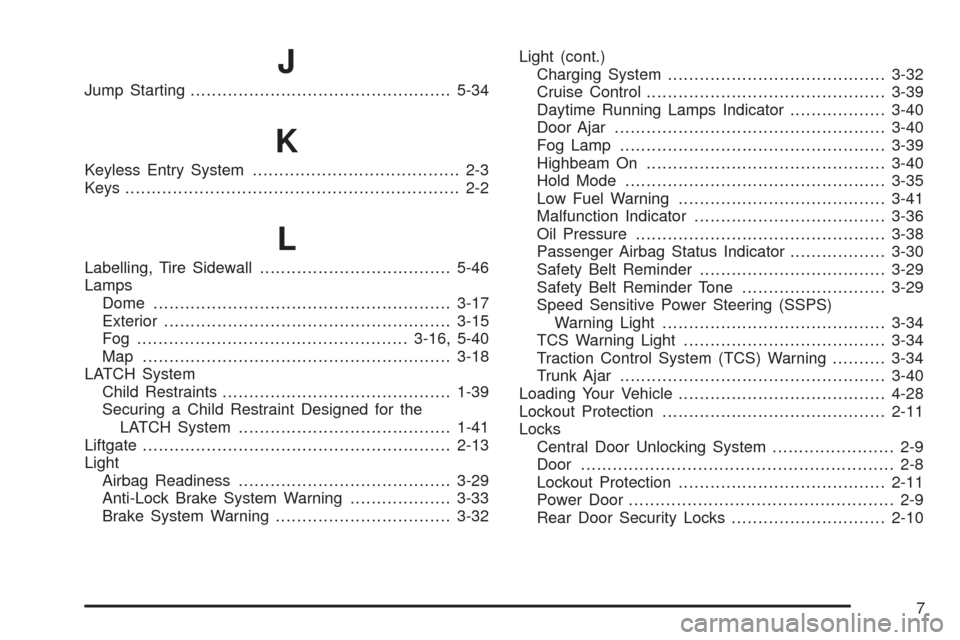2005 CHEVROLET OPTRA 5 traction control
[x] Cancel search: traction controlPage 178 of 336

Driving in Rain and on Wet Roads
Rain and wet roads can mean driving trouble. On a wet
road, you cannot stop, accelerate, or turn as well
because your tire-to-road traction is not as good as on
dry roads. And, if your tires do not have much tread
left, you will get even less traction. It is always wise to
go slower and be cautious if rain starts to fall while
you are driving. The surface may get wet suddenly when
your reflexes are tuned for driving on dry pavement.The heavier the rain, the harder it is to see. Even if your
windshield wiper blades are in good shape, a heavy
rain can make it harder to see road signs and
traffic signals, pavement markings, the edge of the road,
and even people walking.
It is wise to keep your windshield wiping equipment in
good shape and keep your windshield washer tank filled
with washer fluid. Replace your windshield wiper
inserts when they show signs of streaking or missing
areas on the windshield, or when strips of rubber start to
separate from the inserts.
Driving too fast through large water puddles or even
going through some car washes can cause problems,
too. The water may affect your brakes. Try to avoid
puddles. But if you cannot, try to slow down before you
hit them.
{CAUTION:
Wet brakes can cause accidents. They will not
work as well in a quick stop and may cause
pulling to one side. You could lose control of
the vehicle.
After driving through a large puddle of water
or a car wash, apply your brake pedal lightly
until your brakes work normally.
4-16
Page 253 of 336

Uniform Tire Quality Grading
Quality grades can be found where applicable on the
tire sidewall between tread shoulder and maximum
selection width. For example:
Treadwear 200 Traction AA Temperature A
The following information relates to the system
developed by the Unites States National Highway Traffic
Safety Administration, which grades tires by treadwear,
traction and temperature performance. (This applies
only to vehicles sold in the United States.) The grades
are molded on the sidewalls of most passenger car
tires. The Uniform Tire Quality Grading system does not
apply to deep tread, winter-type snow tires, space-saver
or temporary use spare tires, tires with nominal rim
diameters of 10 to 12 inches (25 to 30 cm), or to some
limited-production tires.
While the tires available on General Motors passenger
cars and light trucks may vary with respect to these
grades, they must also conform to federal safety
requirements.
Treadwear
The treadwear grade is a comparative rating based on
the wear rate of the tire when tested under controlled
conditions on a specified government test course.
For example, a tire graded 150 would wear one and
a half (1
1⁄2) times as well on the government course as
a tire graded 100. The relative performance of tires
depends upon the actual conditions of their use,
however, and may depart significantly from the norm
due to variations in driving habits, service practices and
differences in road characteristics and climate.
Traction — AA, A, B, C
The traction grades, from highest to lowest, are AA, A,
B, and C. Those grades represent the tire’s ability
to stop on wet pavement as measured under controlled
conditions on specified government test surfaces of
asphalt and concrete. A tire marked C may have poor
traction performance. Warning: The traction grade
assigned to this tire is based on straight-ahead braking
traction tests, and does not include acceleration,
cornering, hydroplaning, or peak traction characteristics.
5-55
Page 329 of 336

J
Jump Starting.................................................5-34
K
Keyless Entry System....................................... 2-3
Keys............................................................... 2-2
L
Labelling, Tire Sidewall....................................5-46
Lamps
Dome........................................................3-17
Exterior......................................................3-15
Fog ...................................................3-16, 5-40
Map ..........................................................3-18
LATCH System
Child Restraints...........................................1-39
Securing a Child Restraint Designed for the
LATCH System........................................1-41
Liftgate..........................................................2-13
Light
Airbag Readiness........................................3-29
Anti-Lock Brake System Warning...................3-33
Brake System Warning.................................3-32Light (cont.)
Charging System.........................................3-32
Cruise Control.............................................3-39
Daytime Running Lamps Indicator..................3-40
Door Ajar...................................................3-40
Fog Lamp..................................................3-39
Highbeam On.............................................3-40
Hold Mode.................................................3-35
Low Fuel Warning.......................................3-41
Malfunction Indicator....................................3-36
Oil Pressure...............................................3-38
Passenger Airbag Status Indicator..................3-30
Safety Belt Reminder...................................3-29
Safety Belt Reminder Tone...........................3-29
Speed Sensitive Power Steering (SSPS)
Warning Light..........................................3-34
TCS Warning Light......................................3-34
Traction Control System (TCS) Warning..........3-34
Trunk Ajar..................................................3-40
Loading Your Vehicle.......................................4-28
Lockout Protection..........................................2-11
Locks
Central Door Unlocking System....................... 2-9
Door........................................................... 2-8
Lockout Protection.......................................2-11
Power Door.................................................. 2-9
Rear Door Security Locks.............................2-10
7
Page 335 of 336

Traction
Control System (TCS).................................... 4-8
Control System Warning Light.......................3-34
Transaxle
Fluid, Automatic...........................................5-19
Fluid, Manual..............................................5-19
Transaxle Operation, Automatic.........................2-21
Transaxle Operation, Manual............................2-25
Trip Odometer................................................3-28
Trunk............................................................2-11
Trunk Ajar Light..............................................3-40
Turn and Lane-Change Signals.........................3-10
Turn Signal/Multifunction Lever........................... 3-9
U
Understanding Radio Reception........................3-53
Uniform Tire Quality Grading............................5-55
V
Vehicle
Control........................................................ 4-5
Damage Warnings........................................... iv
Loading......................................................4-28
Parking Your...............................................2-30
Symbols......................................................... ivVehicle Data Collection and Event
Data Recorders............................................. 7-9
Vehicle Identification
Number (VIN).............................................5-75
Service Parts Identification Label...................5-75
Ventilation Adjustment......................................3-24
Visors...........................................................2-16
W
Warning Lights, Gages and Indicators................3-26
Warnings
Hazard Warning Flashers............................... 3-8
Other Warning Devices.................................. 3-8
Safety and Symbols......................................... iii
Vehicle Damage.............................................. iv
Wheels
Alignment and Tire Balance..........................5-56
Replacement...............................................5-56
Where to Put the Restraint...............................1-34
Windows.......................................................2-14
Manual......................................................2-15
Power........................................................2-15
Windshield
Wiper Blades, Cleaning................................5-71
Windshield Washer.........................................3-12
Fluid..........................................................5-29
13